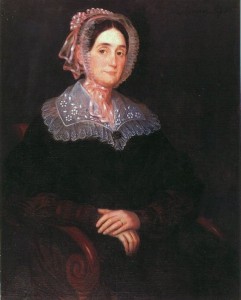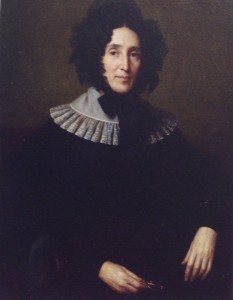Jacques Lucien Amans Portrait of Josephine Roman Aime, c. 1838, (figure 1), exemplifies his standard

work. The woman poses against a nondescript, dark grey backdrop, wearing a modest long-sleeved ebony-colored dress with a pleated white Chantilly lace collar. Her light pink tulle bonnet frames her face in a wreath of ruffles. Amans uses his neoclassical technique to meticulously render Aime’s rich and modest fashions, highlighting her elevated social status and virtuousness.
Through Aime’s high-strung collar and bonnet, her stoic expression, and the flattering neoclassical light in which she is painted, we get a sense of her position in society. Josephine Roman Aime embodied the wealthy French Creole planter class. As the sister of JT Roman (of Oak Alley Plantation fame), and the wife of sugar tycoon Valcour Aime, the prosperous socialite resided in her palatial plantation home known as “Le Petit Versailles.”[1] Amans articulates Aime’s elevated social status through small details like the plush fabric of her bonnet and delicate lace of her collar. According to scholar Judith H. Bonner, the plain background used here was typical for elegant portraiture displayed in the grand homes of the antebellum South,[2] and Aime clearly lived in one of the grandest antebellum homes in the area where this portrait could hang. We also know Aime holds a measure of European sentimentality because her

estate was affectionately known as “Le Petite Versailles,” and she—or her husband, nicknamed Louis the XIV of Louisiana—selected the École des Beax-Arts trained Amans as her portraitist.
This work epitomizes Amans general work in New Orleans. These stylistic hallmarks are echoed in similar compositions, such as Amans’ 1842 Portrait of a Gentlewoman (Figure 2). The similarity between these two portraits of white female sitters further illustrates how Amans painting of a mixed-race woman, Creole in a Red Headdress, constitutes a clear artistic departure from his standard portraiture.
R.C.V.
[1] Platt, R. Eric. “Valcour Aime.” KnowLA Encyclopedia of Louisiana. Ed. David Johnson. Louisiana Endowment for the Humanities, 18 Sept. 2014.
[2] McAlear, Donna. “Portraiture, Landscapes, and Marine Scenes in Nineteenth-Century Louisiana.” Collecting Passions: Highlights from the LSU Museum of Art Collection. Baton Rouge, LA: LSU Museum of Art, 2005. 40-44. Print.